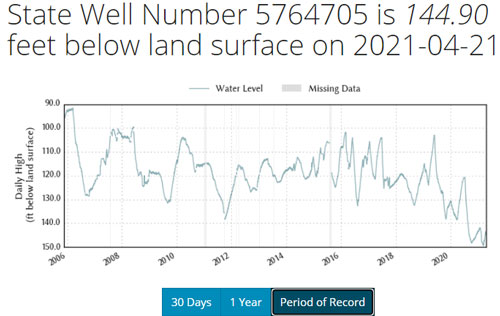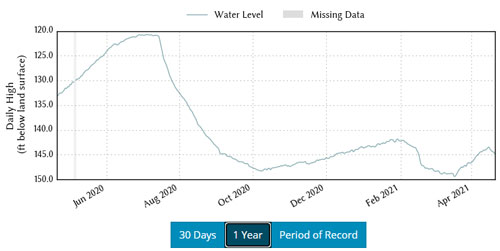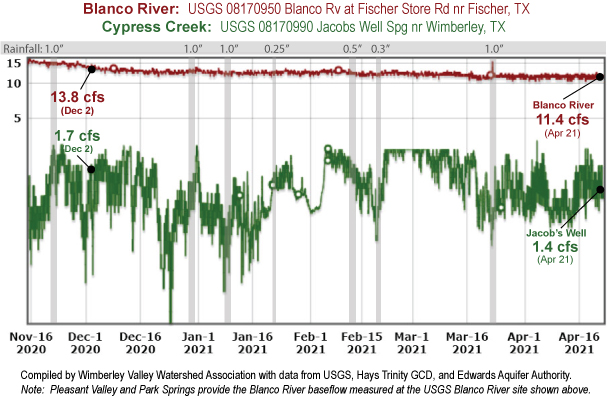Lowest Groundwater Level Recorded Since 2005
April 2021 Hydro Report
Groundwater, springs, creeks, and rivers are connected in the Hill Country. In March, groundwater levels in the HTGCD Mt. Baldy monitor well, a Middle Trinity Aquifer (Cow Creek) well, reached the lowest level recorded since Nov. 2005 (Fig. 1). Most of Western Hays County residents rely on either wells or groundwater-supplied water utilities. Many groundwater conservation districts (see table below for specifics) have declared drought and are enforcing pumpage curtailments to extend water supplies until rainfall can replenish groundwater supplies.
Typically, fall and winter rains generate recharge to replenish groundwater supplies–but the series of small rainfall events during this year’s wet season didn’t create much runoff, and therefore, not much recharge reached our aquifers (Fig. 2). The exceptionally low water levels in monitor wells reinforces the importance of water conservation while drought conditions persist.
In the Hill Country, spring flow and streamflow are good indicators of groundwater conditions. Figure 3 shows a hydrograph of baseflow provided by Middle Trinity Aquifer springs in the Blanco River and Cypress Creek correlated with rainfall totals. As water levels in the aquifer decline, spring flow decreases.
In many ways, we are in the middle of a sneaky drought. Small rain events have supplied enough water to support surface vegetation, but they haven’t generated enough runoff to recharge area aquifers. With these dry conditions, rainfall is absorbed by exceptionally dry soils. After the prolonged dry conditions, it will take several consecutive rains to wet the soils before sustained recharge can refill the aquifers.
On March 23, the EAA weather station near Burnett Ranches measured 0.76 inches and a private weather station in downtown Wimberley measured 0.93 inches of rain. Given dry soils, this welcome rainfall did little to replenish groundwater supplies. In western Hays County, baseflow conditions at the Blanco River and Cypress Creek have seen steady declines throughout the fall and winter.
Such low spring flow is an exceptionally troubling condition; however, watching the flow trends for Middle Trinity springs and taking action as key thresholds are crossed mean we as a community can slow groundwater decline and extend supplies. Springs are a key indicator of groundwater storage and the status of our groundwater supply.
Water conservation now will help extend water resources and protect habitat until enough rain events generate meaningful recharge. Take a moment to tune up your well and clean your pump house and fix pesky drips and leaks. Be part of the collective solution to protect our shared water supply.
Groundwater Drought Declarations
No matter what area agencies call their drought declaration, it’s obvious water levels and spring flows have declined to exceptionally low levels. In order to preserve groundwater availability, coordinated water conservation measures are essential.
| Agency | Drought Stage | Date Declared | Details |
| Hays Trinity GCD | Jacob’s Well GMZ – 30% Curtailment Remaining GCD – 20% Curtailment |
Nov. 2020 | Board Order, 11/1/2020 |
| Barton Springs Edwards Aquifer CD | Stage II Alarm Drought (20% Curtailment or more) | Oct. 2020 | Press Release, 10/9/2020 |
| Edwards Aquifer Authority | San Antonio Pool is in Stage 2 – 30% Reduction | Apr. 2021 | Press Release, 4/20/2021 |
[Updated 4/22/2021]
For updates, useful links, and archived Hydro Reports, visit the WVWA Water Monitoring page.


